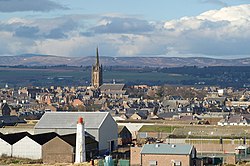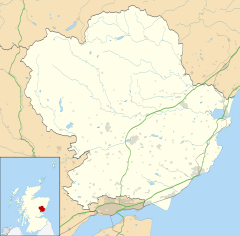Montrose, Scotland
Montrose
|
|
|---|---|
 |
|
| Montrose shown within Angus | |
| Population | 11,955 (2011 Census) |
| OS grid reference | NO715575 |
| • Edinburgh | 59 mi (95 km) |
| • London | 371 mi (597 km) |
| Council area | |
| Lieutenancy area | |
| Country | Scotland |
| Sovereign state | United Kingdom |
| Post town | MONTROSE |
| Postcode district | DD10 |
| Dialling code | 01674 |
| Police | Scottish |
| Fire | Scottish |
| Ambulance | Scottish |
| EU Parliament | Scotland |
| UK Parliament | |
| Scottish Parliament | |
Montrose (/mɒnˈtroʊz/ mon-TROHZ, Scottish Gaelic: Monadh Rois) is a coastal resort town and former royal burgh in Angus, Scotland. It is situated 38 miles (61 kilometres) north of Dundee between the mouths of the North and South Esk rivers. It is the northernmost coastal town in Angus and developed at a natural harbour that traded in skins, hides and cured salmon in medieval times.
With a population of approximately 12,000, the town functions as a port, but the major employer is GlaxoSmithKline, which was saved from closure in 2006. The skyline of Montrose is dominated by the 220-foot (67 m) steeple of Old and St Andrew's Church, designed by James Gillespie Graham and built between 1832 and 1834.
Montrose is a town with a wealth of architecture, and is a centre for international trade. It is an important commercial port for the thriving oil and gas industry. It is known for its wide thoroughfare and high street which leads to picturesque closes containing secluded gardens. The town has a view of a 2 mi (3 km) square tidal lagoon, Montrose Basin, which is considered a nature reserve of international importance. It is the largest inland salt water basin in the UK, and an important habitat for the mute swan. Just outside Montrose is the 18th-century House of Dun, designed by the Scottish architect William Adam and built in 1730 for David Erskine, 13th Laird of Dun.
...
Wikipedia

